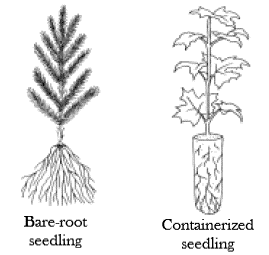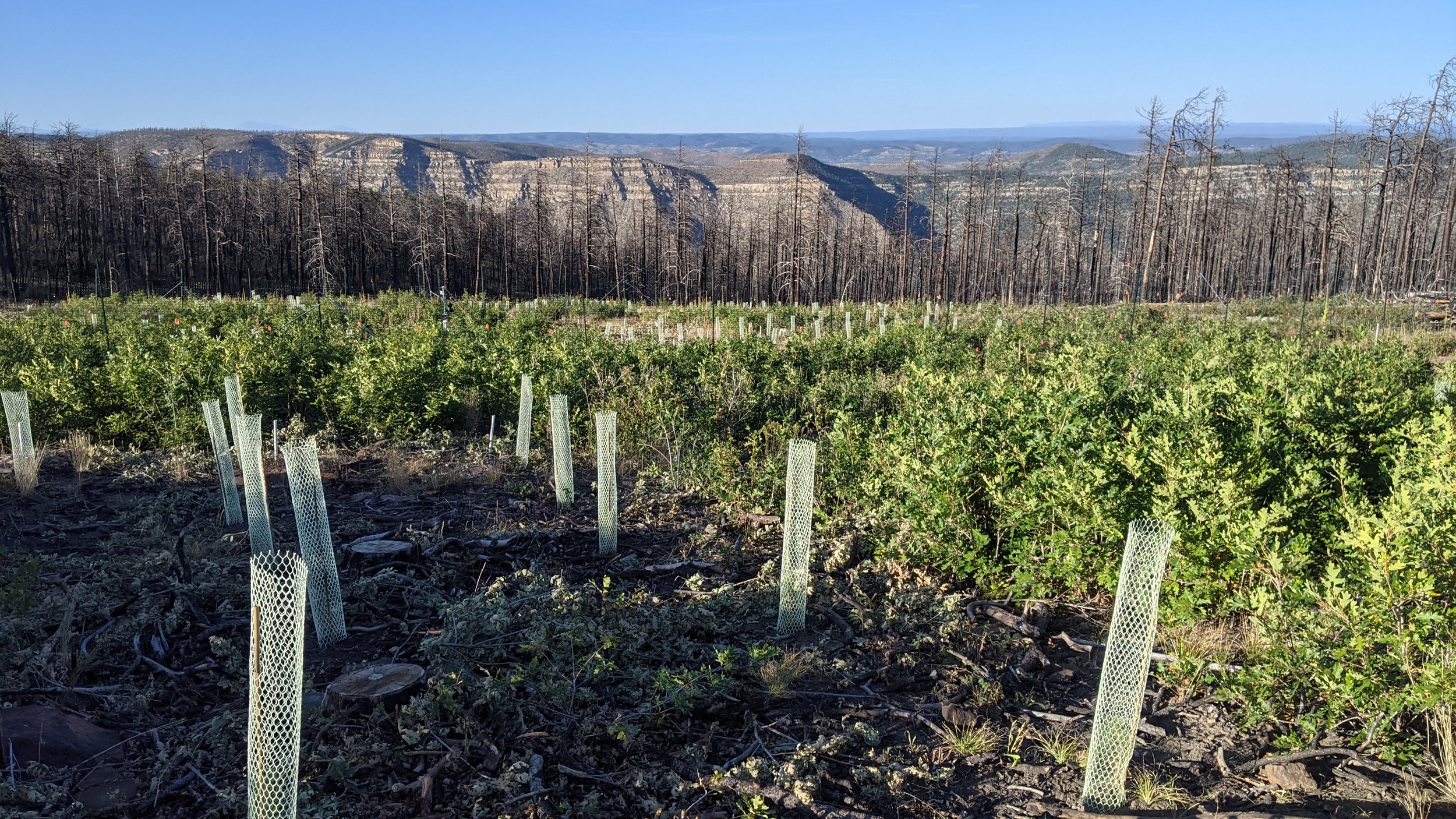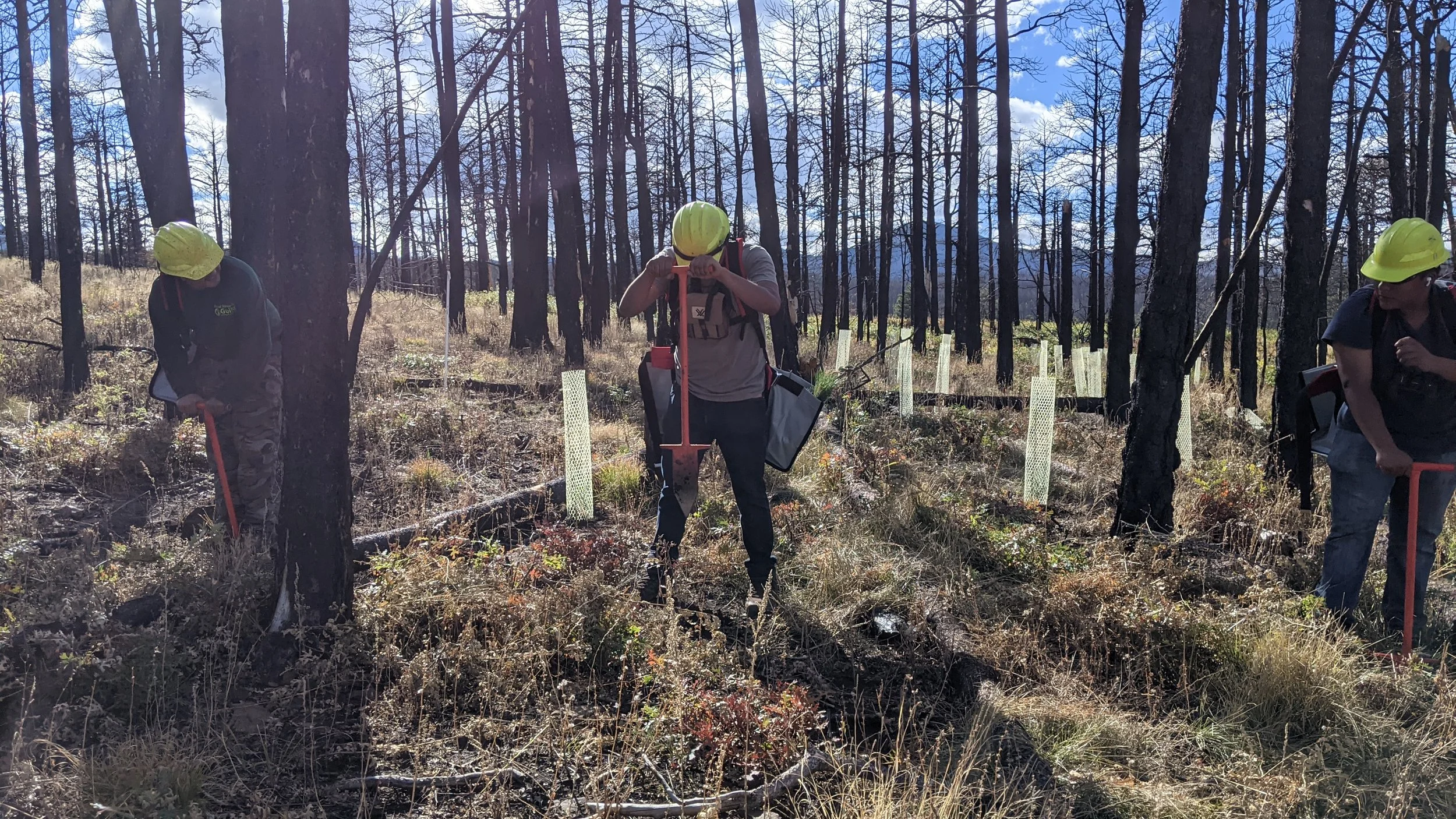New Mexico has a long path of wildfire recovery ahead. Those affected can learn more about what post-fire recovery looks like by visiting the After Wildfire (afterwildfirenm.org) website.
Happy Wednesday, Fireshed!
We hope you enjoyed the cool weather over the weekend before things heat up again. With many fires still burning across the state, natural resource managers are starting to think about what comes after the flames. In some areas this may mean post-fire debris flow and flooding mitigation, hillslope stabilization and erosion reduction, or road and trail treatments. For those areas which were burned at high-severity and no longer have live “seed” (producing) trees on the landscape, post-fire treatments may include manual reforestation.
Today’s Wildfire Wednesday features:
The need for reforestation
Engineering climate-resilient trees
Best wishes,
Rachel
The Need for Post-fire Reforestation
What is it and why should we intervene?
Reforestation is defined as “the action of renewing forest cover (as by natural seeding or by the artificial planting of seeds or young trees)”. In New Mexico and beyond, private, university, state, and federal research centers and companies are working to collect tree seeds, grow seedlings in greenhouses and fields, and plant those baby trees in deforested areas.
Climate change-driven wildfires are trending toward burning bigger, longer, and hotter than in our recorded history. Larger portions of these fires, driven by their self-made weather systems, are also burning at high-severity, killing vast swaths of trees and understory vegetation and scorching the soil and the landscape. Because of the damage and the lack of live seed trees, sometimes for miles, these scarred landscapes are susceptible to ecosystem type shifts, meaning that a place which was once a forest is susceptible to not being able to come back as a forest. This is where land managers who recognize the ecological, social, cultural, and inherent benefits of forests step in.
Where does reforestation start?
Imagine walking through a green healthy forest, tall trees with thick branches reaching for the sun above you, squirrels scampering up the trunks and chirping to one another as they look for pine cones. This is where reforestation begins, in this existing mature forest. Fresh cones with a hearty bank of seeds inside will be collected from these trees and taken back to a nursey where they will be tested for viability, labeled, stored, and eventually germinated and grown into seedlings in greenhouses. Researchers like Owen Burney with New Mexico State University’s Forestry Research Center conduct targeted collection of seeds to source them from the healthiest trees growing on hot and dry southern slopes, trees which already show the most promise of being able to survive in a hot and dry future. These researchers may subject the baby trees to additional environmental stress in their first year of life, withholding water to encourage the trees to develop drought-tolerance. The seedlings will be tended to and grown in the batches of tens- to hundreds-of-thousands. Read more about this type of engineering.
Once the trees are old enough to plant, typically 1-3 years, they will be packaged up in their small containers or dirt plugs and transported to the field site for manual planting by skilled forestry workers carrying a specialized shovel and up to 100 baby trees at a time in their hip bags. Prior to planting, however, the field site needs to be selected and prepared.
Building a Stronger Future Forest
Engineering climate-resilient forests means picking the right place for them to grow.
Selecting a site for reforestation starts with the question: what is the objective? Foresters think on the scale of hundreds of years, knowing that the trees they hope to plant may not be mature seed-producing forests until long after they’re retired. With this in mind, foresters need to be able to picture the future forest which will meet their objectives and then plant to create that forest. For climate-resiliency, site selection considerations might include finding areas which are going to be shadier, cooler, and wetter than the surrounding landscape. Called microclimates, these areas retain soil moisture and relative humidity which will lessen the amount of environmental stress on the trees, allowing them to grow quickly and become established. Such sites might exist on north-facing slopes and in drainages or other low spots. The process of planting in clumps and focusing reforestation efforts in these favorable microclimates is called nucleation, the goal of which is to create a seed-producing cluster of trees which will then be able to naturally reforest the surrounding area (INSERT PHOTO OF REFUGIA SITE). This approach to artificial reforestation focuses time, effort, and money on areas which are most likely to yield success. As one article in the Scientific American put it, “Southwest forest experts have spent years devising ways to outsmart climate change and give these forests a fighting chance.”
Giving the trees their best chance.
After the site selection is complete, land managers need to prepare the area for planting. Following a fire which burns at high-severity, the soil is often scorched and scarred with much of the healthy organic material burned away. This soil is susceptible to erosion, degradation, debris-flows, and landslides. Land managers may work to stabilize slopes with directional felling of fire-killed trees and ground cloth, prepare drainages for flooding with weirs, and ensure that the baby trees they are preparing to put in the ground will not be buried, desiccated, or swept away in a debris flow. Small shrubs and bushes such as oak also regenerate quickly in fire scars and can out-compete the baby trees, requiring brush removal prior to planting.
Planting itself is a team effort and a labor of love. Artificial planting of container trees and plugs is done by hand by folks walking out, finding a suitable spot which will offer the tree some shelter and precipitation retention as it grows, and digging a deep hole in which to plant that tree, roots all pointing down, before covering it back up and moving on to the next tree. Crews can plant thousands of trees in a day, reforesting the landscape with 10-inch-tall sprouts of hope. Read more about the work of NMSU and the Forest Stewards Guild planting on the Philmont Scout Ranch here.
Planting seeds of hope.
Hope is ultimately what artificial reforestation boils down to – the hope that these trees will survive, thrive, be resilient against the many threats of climate change and drought, and grow into the future forests of the Southwest.
Learn more about reforestation in this article about reforesting the Giant Sequoias.






